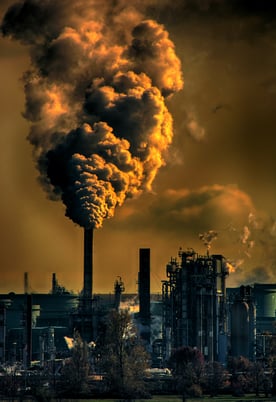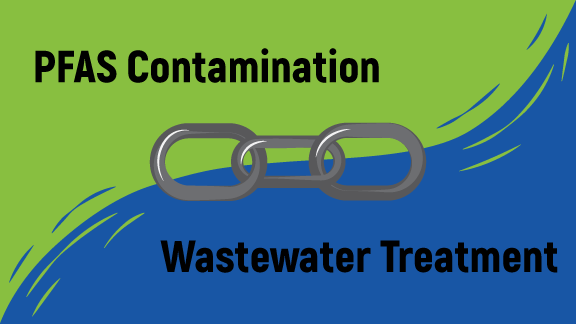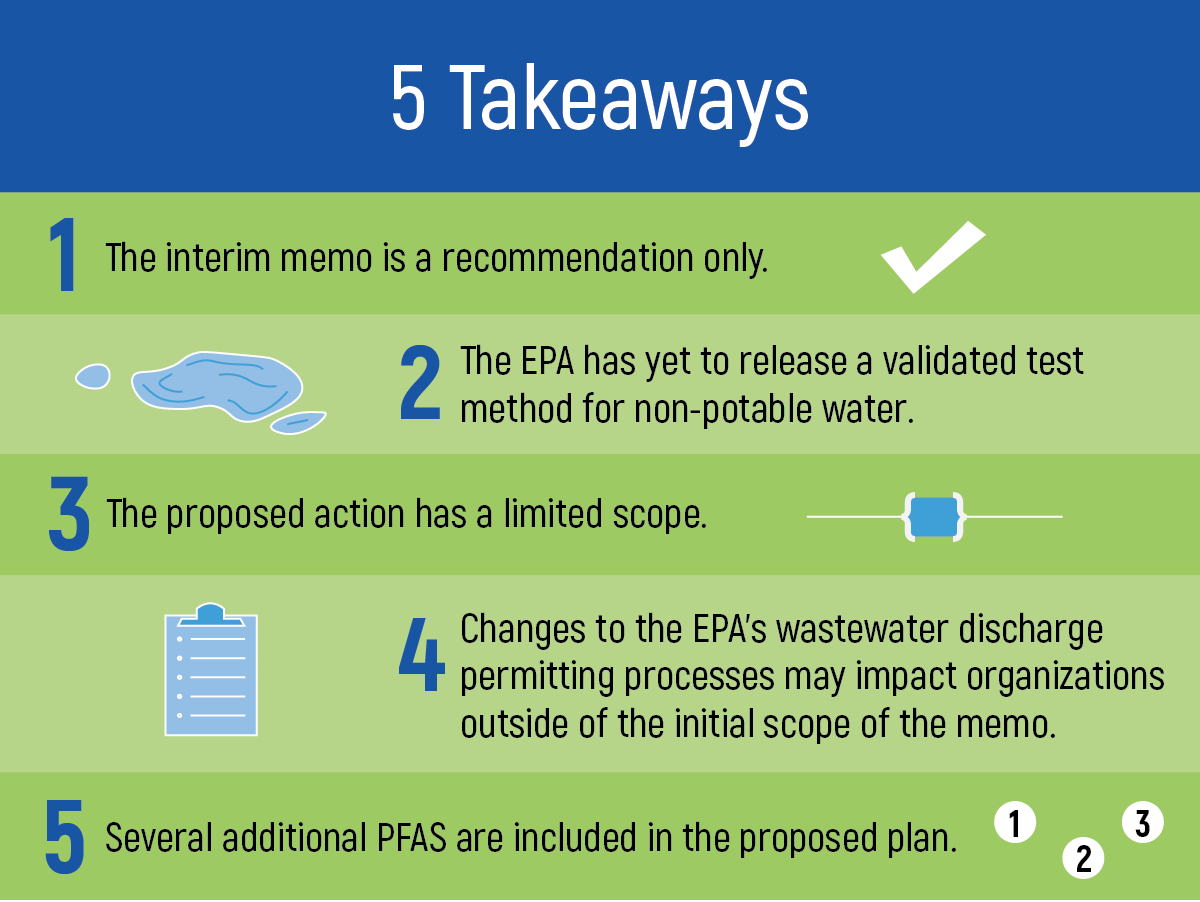One of the questions we often get asked is whether wastewater treatment processes remove PFAS. Here’s the bottom line. You won’t be able to rely on your local wastewater treatment plant to solve your PFAS problem for you. That’s because traditional wastewater treatment processes do not remove PFAS. In fact, they can convert PFAS precursors into PFAS.
How PFAS Enters the Wastewater Treatment System
To understand the link between PFAS and wastewater, let’s take a closer look at the inputs and outputs of a typical wastewater treatment facility to see how traditional wastewater treatment practices can contribute to PFAS contamination. To be clear, municipal wastewater treatment plants are sometimes receivers of wastewater containing PFAS, they are not the original sources of PFAS contamination.
Industry: The first input we need to consider is the upstream industry. Whether these companies manufacture the PFAS chemicals themselves or include PFAS compounds in their production processes, they can release PFAS chemicals in a variety of ways.
Wastewater from production: When water is used in manufacturing production, it can become contaminated with PFAS. In some industries, this wastewater can be recycled back into the production process. When it can’t, it is often treated and then released into the environment where it can contaminate local waterways and groundwater. Currently, MI is one of the few states that has PFAS sampling requirements as part of its industrial wastewater discharge permits.
Some industrial wastewater is sent into the sewer system after an initial treatment to remove solids, oils, and other contaminants. From there, it flows to the same municipal wastewater treatment plant that processes domestic wastewater. (The water that flows down our sinks, toilets, and shower drains.)
Leachate from landfill: Nearly every industry produces waste that winds up in a landfill. When a liquid (rain, condensation, liquid waste) passes through solid waste, the liquid byproduct is called “leachate.” If liquid passes through and from waste that contains PFAS, it’s likely that the leachate will too. If the landfill has a leachate collection system installed, the leachate is often sent to the local wastewater treatment plant for processing.
Domestic waste: The second input is the household waste produced by the community. When products made using PFAS compounds are disposed of, they can contaminate the surrounding environment. To minimize contamination, municipal landfills are lined, and the leachate is collected. Again, this leachate is typically sent to the local wastewater treatment plant for processing.
Firefighting foam: Finally, the surfactant characteristic of PFAS compounds make them particularly effective for extinguishing chemical fires and fires fueled by flammable liquids. Aqueous film-forming foam (AFFF) used by firefighters has contained PFAS for decades. For years the primary PFAS chemical used was PFOS, but its use was discontinued in 2002 to be replaced by other PFAS compounds with similar properties.

Newer, fluorine-free AFFF products are available, but AFFF has a long shelf life, so stockpiles are still in use and storage. In addition, one of the primary uses of AFFF is to fight aviation fires. You can find more information about the FAA’s research into fluorine-free foams (FFF) on the agency’s website, but the FAA has yet to approve these newer formulations for use in aviation emergencies.
“Recently, new foam formulas known as fluorine-free foams (FFFs) have shown potential to replace current AFFFs, but they have not yet been proven to possess equivalent fire-extinguishing capabilities—a disadvantage which could require additional capacity for foam and/or additional trucks and delay fire extinguishment, when every moment is precious. For these reasons, the FAA plans to evaluate FFFs and assess performance standards for FFFs use at airports.”
FAA website, cited Nov 30, 2020
So, the contamination scenario goes like this: There is an emergency or training exercise in which AFFF is used. The liquid fuel for the fire mixed with AFFF can contaminate neighboring surface water if not completely contained. Also, once the fire has been extinguished, firefighters may hose down the area. The resulting runoff can contaminate soil, ground, and surface waters directly, but if the runoff is directed into a storm drain, it will flow to the local wastewater treatment facility or surface water body.
How Wastewater Treatment is a Link in the PFAS Chain
That was a quick look at how PFAS contamination enters the wastewater treatment plant. As I noted in the introduction, traditional wastewater treatment processes do not remove PFAS. And they can convert PFAS precursors into PFAS. Now, let’s consider the outputs to see how PFAS enters the water and food supply.
Treated water discharge – Once wastewater is treated, it is discharged into the local environment. If this treated effluent contains PFAS, it then contaminates its receiving water that may be a source water for a downstream public water supply.
Biosolids – Wastewater treatment processes also produce a significant amount of sludge, often referred to as biosolids when it’s land applied as fertilizer. The EPA estimates that approximately 60% of these biosolids are applied for agricultural purposes, potentially introducing PFAS that are bioaccumulative into the food chain through plant uptake. Some states and municipalities are re-examining the practice of using biosolids produced by wastewater treatment as a cheap fertilizer, but the alternative is to send these biosolids to a landfill. From here, they can reenter the wastewater treatment process via leachate.
Do I need to sample influent as well as effluent at my wastewater treatment plant?
Let me end our discussion by answering a common question we get from wastewater treatment operators: Do I need to sample influent as well as effluent for PFAS?
As always, the first place to look is at the regulations. Some states may require wastewater treatment plant operators to test influent to determine whether they are receiving PFAS from industry. For example, as part of a crackdown on industrial PFAS contamination, MI required its wastewater treatment operators to test influent to determine whether they were receiving PFAS-contaminated industrial wastewater.
If there are no regulatory drivers or permit limits you need to consider, sampling influent may be sufficient since PFAS pass through wastewater treatment plant processes for the most part unchanged. However, if you have detectable levels of PFAS in your effluent, it may be useful to sample influent as well to determine if effluent levels are caused by PFAS compounds or PFAS precursors. If PFAS is detected in either influent or effluent, it’s likely to be advisable to sample upstream to determine the actual source of PFAS contamination. Again, WWTPs are sometimes receivers of PFAS contamination from upstream sources and are not the original source. Ultimately, it’s a decision your project team will need to make based on their objectives.
If you have additional questions about PFAS contamination and wastewater treatment or need assistance planning a project, please reach out to us directly. One of our advisors would be happy to help.





